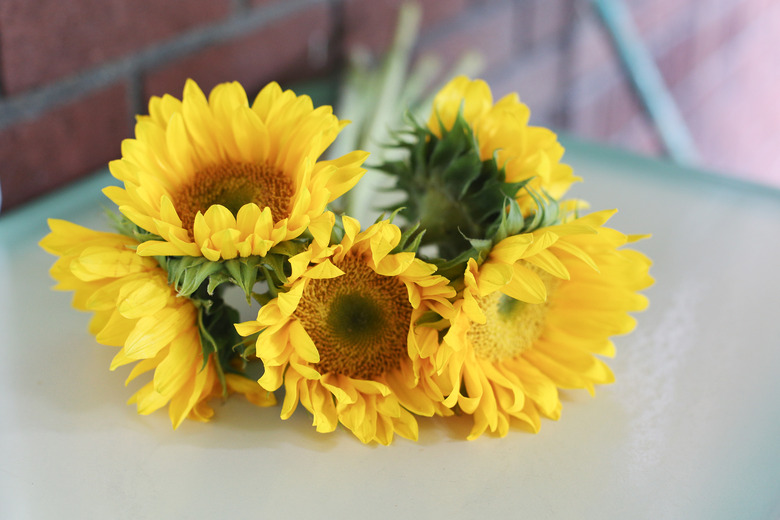What Should You Do With Sunflowers After They Bloom?
We may receive a commission on purchases made from links.
The yellow faces of sunflowers (Helianthus spp.) symbolize the bright, sunny days of summer. Different types of the sun-loving, thirsty flowers grow in both annual and perennial flower gardens. Once the large, beautiful blooms mature, you can use them for decorative purposes or harvest the seeds as part of a summer garden crop.
Tip
Sunflowers can be used for cut flower arrangements, sunflower seed harvesting and, after they're mature, feeding animals.
Varieties of Sunflowers
Varieties of Sunflowers
Perennial sunflowers are generally smaller than many of their annual counterparts and grow in early spring as clumps of flowers. They have small seeds and grow from underground stems known as rhizomes. Perennial sunflowers grow throughout U.S. Department of Agriculture plant hardiness zones 3 through 9, depending on species.
Sunflowers growing as annuals can have either small or large seeds. They bloom in late spring to summer in the year they're planted and have stringy roots. Both types of sunflowers produce edible seeds, although the largest varieties have the best seeds for snacking.
Two popular sunflower cultivars are 'Maximilian' and 'Mammoth.' The perennial 'Maximilian' (Helianthus maximiliani, USDA zones 4-9) is a tall, native prairie sunflower that blooms from August through November. 'Mammoth' (Helianthus annuus 'Mammoth') blooms over the summer with traditional bright yellow heads up to 1 foot across. Growing up to 12 feet tall, these fast and easy-to-grow flowers provide plentiful seeds at harvest time.
Cutting Sunflowers for Arrangements
Cutting Sunflowers for Arrangements
Bring the beauty of sunflowers indoors by cutting some of the blooms for a floral arrangement. Cut the sunflowers when they're just starting to open to enjoy the blooms for longer, harvesting them in the morning after the dew dries. Using sharp pruning shears, cut the stem at the desired length based on the vase size. Remove the leaves from the stems, leaving only the leaves closest to the flower. Place the cut sunflowers in water immediately.
Harvesting Sunflower Seeds
Harvesting Sunflower Seeds
While sunflowers are beautiful to look at, their seeds are also a valuable crop. To harvest the seeds for use, wait until the backs of the flower heads turn yellow, dry out and turn brown. This usually happens 30 to 45 days after blooming. Once the seeds dry completely, cut the head off about 4 inches down the stem. Remove the seeds using your fingers or a fork.
Sunflower Pest Protection
Sunflower Pest Protection
When you dry sunflowers outside, they can become a temptation for outdoor animals like birds and squirrels. To protect the heads, cover them with a light, breathable fabric like cheesecloth, and secure it with a twist-tie below the head. Alternatively, you can cut the flower head early along with at least 2 feet of stem and bring them inside to dry. Hang the heads upside down in an area where pets or indoor pests can't get to them.
Sunflower Seed Preparation
Sunflower Seed Preparation
With many cultivars of sunflowers available, there are many sizes of seeds. Smaller flowers with small solid black seeds are generally used for animal and bird feed or by industry for making oils. Larger, striped seeds are best for human snacking.
To prepare these larger seeds to eat, soak them overnight in 1 gallon of water mixed with 1 cup of salt. Dry them in an oven set to 250 degrees Fahrenheit for four to five hours. Store the salted and dried seeds in an airtight container.
Feeding Sunflower Seeds to Animals
Feeding Sunflower Seeds to Animals
Share your bounty with furry or feathered friends in your neighborhood. If you want to let the birds eat the seeds, you can leave the sunflower heads on the plants. The birds, squirrels and other animals can find the seeds easily. Want to store up a winter harvest for the animals? Harvest the seeds as you would for your own consumption, and you can put the seeds out for the animals a little at a time during the winter.
